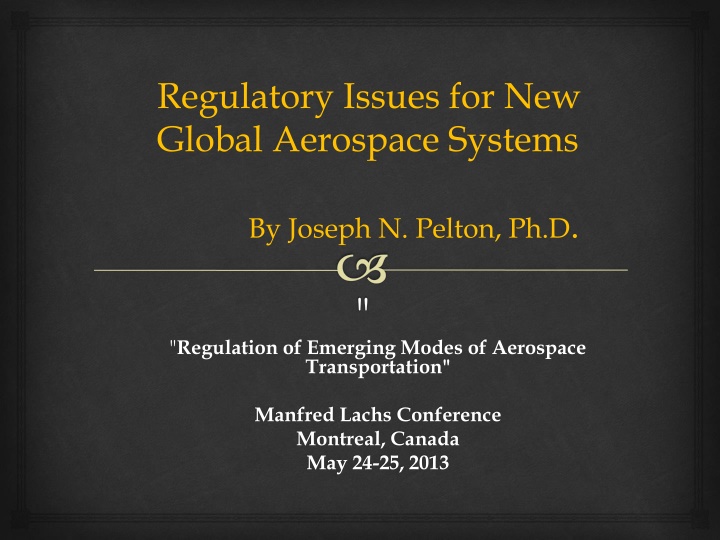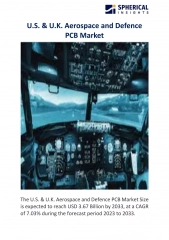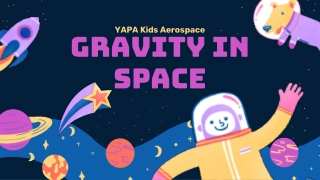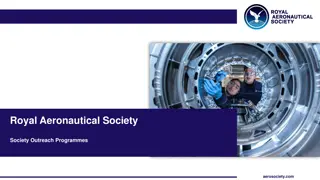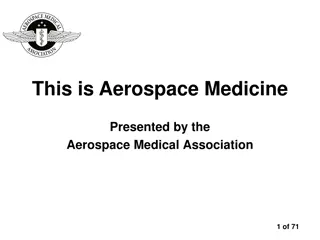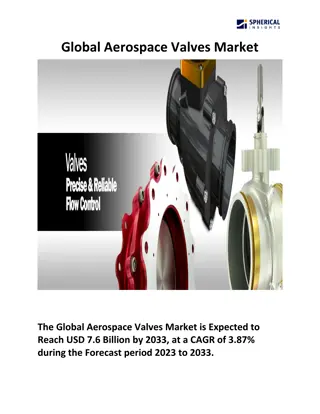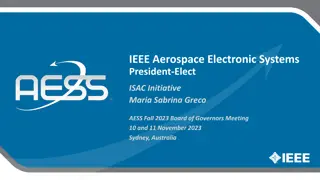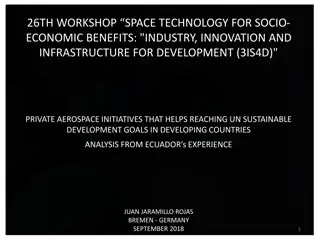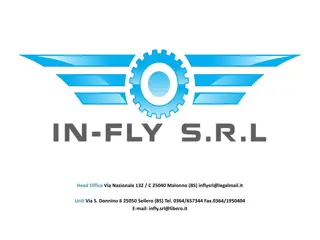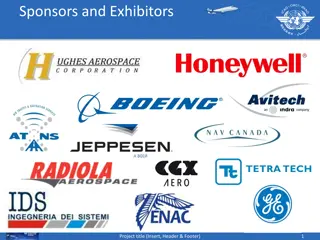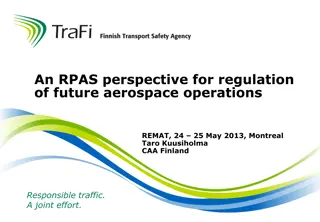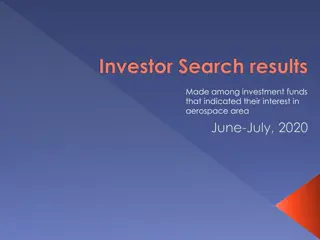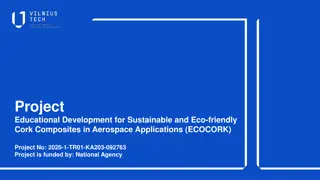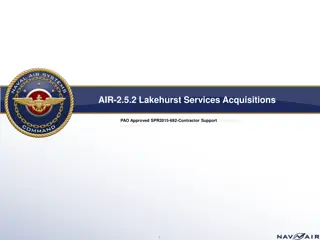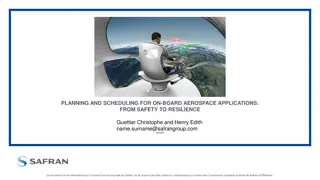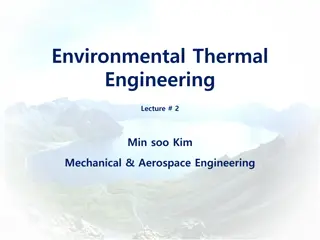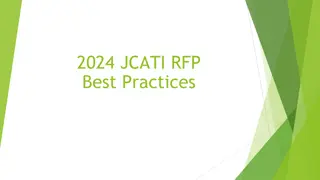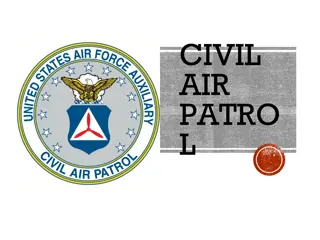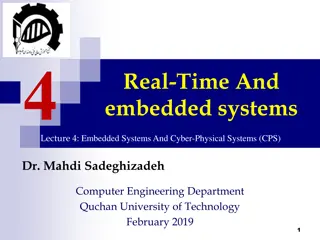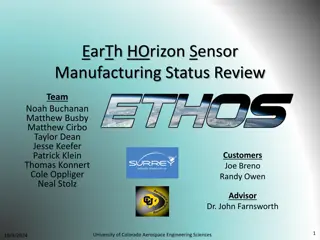Critical Aspects of Regulations in Global Aerospace Systems
The regulatory issues and challenges surrounding new developments in aerospace systems, such as airplanes, jets, sub-orbital space planes, and rockets to orbit, are explored. The diversity of technical designs in commercial space transportation concepts, market size projections, and subsystem standardization for certification are discussed, shedding light on the evolving landscape of air and space services.
Download Presentation

Please find below an Image/Link to download the presentation.
The content on the website is provided AS IS for your information and personal use only. It may not be sold, licensed, or shared on other websites without obtaining consent from the author.If you encounter any issues during the download, it is possible that the publisher has removed the file from their server.
You are allowed to download the files provided on this website for personal or commercial use, subject to the condition that they are used lawfully. All files are the property of their respective owners.
The content on the website is provided AS IS for your information and personal use only. It may not be sold, licensed, or shared on other websites without obtaining consent from the author.
E N D
Presentation Transcript
Regulatory Issues for New Global Aerospace Systems By Joseph N. Pelton, Ph.D. " "Regulation of Emerging Modes of Aerospace Transportation" Manfred Lachs Conference Montreal, Canada May 24-25, 2013
Comparing Airplanes, Jets, Sub-Orbital Space Planes and Rockets to Orbit SIGNIFICANT DIFFERENCES IN AIRBORNE VEHICLES Comparative Factor Airplane Jet Spaceplane Rocket to Low Earth Orbit 7800 Velocity (meters/sec) 250 500 1600 Height (km) Up to 10 Up to 15 Up to 120 200+ Specific Energy (Joules/kg) 0.13 0.7 14.5 324
Diversity of Technical Design Demonstrated in Commercial Space Transportation Concepts to Date Launch Concept Organizations (Some of Which Are Now Defunct or Merged) Lighter than Air Ascender- Ion Engine lift from Dark Sky Station JP Aerospace Vertical Takeoff / Vertical landing (VTVL) Vertical Takeoff / Horizontal Landing (VTHL) at Spaceport Armadillo Aerospace, Blue Origin, JAXA, Masten Aerospace, Lockheed Martin/EADS Aera Space Tours, Air Boss, Bristol Space Planes, C & Space, Energia, Lorrey Aerospace, Phoenix & Pre-X by EADS, Space Dev, Space Transportation Corp, Space X, Sub Orbital Corp, Myasishchev Corp. Design Bureau, t/Space, Vela Technologies, Wickman Space and Propulsion Andrews, Scaled Composites, The Spaceship Corporation, Virgin Galactic, XCOR, Project Enterprise by TALIS Institute, DLR, Swiss Propulsion Lab Kelly Space Technology Horizontal Takeoff / Horizontal Landing(HTHL) Tow Launch and Horizontal Landing Vertical Launch to LEO from Space Port Launch to LEO from Jet Plane or Carrier Vehicle Drop Alliant, Inter Orbital Systems Technology, Rocketplane/Kistler, Space HAB, UP Aerospace Triton, Stratolauncher, Launcher One (by Virgin Galactic)
Relative Market Size Emerging Air & Space Service and their Estimated Market Size-2025 Supersonic/Hypersonic Flights into the Extreme Stratosphere $10-100 Bil/yr Commercial launches to low earth orbit $10 Bil/yr Upward Space Tourism/ Space Adventures $ 2 Bil/yr Upward High Altitude Platform Systems-Commercial UAVs $ 2Bil/yr Upward Private Space Stations/Habitats $1-2 Bil/yr Upward Proto-Space Transport $1 Bil/yr Upward Dark Sky Station/Ion engine lift orbit Under $1 Bil/yr
Subsystems for Possible Standardization and Certification for Commercial Space Transportation Environmental control and life support systems Main propulsion system and fuels Guidance Navigation and control systems Avionics and software Main structural systems Thermal protection systems Thermal control systems Health monitoring systems Electrical power system Mechanical systems Flight safety system and black boxes Crew systems
Issues to Address in New Aerospace Systems Issue or Facility Involved Airports servicing HTHL spaceplanes Regulatory/Legal Need Technical Research Need Advanced radar & possibly LIDAR systems Advanced radar & possibly LIDAR systems Advanced radar & possibly LIDAR systems Int l Agencies Additional Concerns Comment Certification and periodic recertification ICAO Coordinatio n of regular aviation and space flights Safety of surrounding area. Liability insurance Safety of surrounding area. Liability insurance Safety of surrounding area. Liability insurance Spaceports supporting HTHL, VTHL, VTVL systems Certification and periodic recertification. Range Safety Control Certification and periodic recertification. Range Safety Control Range Safety Control and High Altitude Range Control ICAO Space Traffic Managemen t & Control Launch Sites supporting conventional and commercial rockets Rocket Launch from Balloon or Parachute ICAO Space Traffic Management & Control Advanced radar & possibly LIDAR systems ICAO Space Traffic Management & Control Safety of surrounding area. Liability insurance
Issues to Address in New Aerospace Systems Issue or Facility Involved Rocket Launch from carrier aircraft Regulatory/ Legal Need Technical Research Need Int l Agencies Additional Concerns Comment Range Safety Control and High Altitude Range Control Advanced radar & possibly LIDAR systems ICAO Space Traffic Manage- ment & Control Space Traffic Manage- ment & Control Space Traffic Manage- ment & Control Safety of surrounding area. Liability insurance Rocket Launch from ocean Range Safety Control and High Altitude Range Control Advanced radar & possibly LIDAR systems ICAO Safety of surrounding area. Liability insurance Ion Engine Craft launched from Dark Sky Station Range Safety Control and High Altitude Range Control Stratospheric collisions avoidance systems, Radiation shielding,. Warning Beacons, ICAO Liability insurance Dark Sky Station and Lighter than Air Craft New types of certification & recertification plus ATC into Stratosphere. Collision avoidance. . Warning Beacons, Advanced radar & LIDAR ITU and perhaps WMO and UNEP Space Traffic Manage- ment & Control Liability insurance
Issues to Address in New Aerospace Systems Issue or Facility Involved Super Sonic & Hypersonic Transport Regulatory/ Legal Need Air Traffic Control into Stratosphere Technical Research Need Int l Agencies Additiona l Concerns Space Traffic Manage- ment & Control Genetic mutation Comment Sonic Beam mitigation standards, Emission standards, Thermal Protection Systems WMO, UNEP and ITU Liability provisions, flight path coordination, solar CMEs Liability provisions, flight path coordination, solar CMEs Incentives for improved propellants. Radiation Exposure levels/Health Standards Radiation Protection Standards, Flight Path Approvals Standards for rocket emissions Ozone hole and Ozone layer investigations World Health Org., WMO, UNDP WMO. UNDP Rocket Pollutant Emissions (N0x, Cox, Water Vapor Orbital Debris (Controlled /uncontrolled reentry) Stratospheric emission studies. Improved propellants Climate Change, Strato- spheric pollution Greater risk of Kessler Syndrome Air Traffic Control and Space Traffic Management Black boxes for all spacecraft. Warning beacons UN COPUOS, IADC, SDA Fund for debris mitigation. Fines for violations
Issues to Address in New Aerospace Systems Issue or Facility Involved Regulatory/ Legal Need Air Traffic Control into Stratosphere Technical Research Need Additional Concerns Comment Int l Agencies Super Sonic & Hypersonic Transport Sonic Beam mitigation standards, Emission standards, Thermal Protection Sys. Ozone hole and Ozone layer investigations WMO, UNEP and ITU Space Traffic Manage-ment & Control Liability provisions, flight path coordination, solar flares/CMEs Radiation Exposure levels/Health Standards Rocket Pollutant Emissions (N0x, COx, Water Vapor Radiation Protection Standards, Flight Path Approvals Standards for rocket emissions World Health Organization, WMO, UNDP Genetic mutation Liability provisions, flight path coordination, solar flares/CMEs Incentives for improved propellants. Stratospheric emission studies. Improved propellants Black boxes for all spacecraft. Warning beacons WMO. UNDP Climate Change, Stratospheric pollution Orbital Debris (Controlled and uncontrolled reentry) Air Traffic Control and Space Traffic Management & Control UN COPUOS, IADC, SDA Heightened risk with Kessler Syndrome Fund for debris mitigation. Fines for violations
Issues to Address in New Aerospace Systems Issue or Facility Involved Electric Vehicles Regulatory/ Legal Need Technical Research Need Zero polluting aircraft Int l Agencies Addition al Concerns Incentive s for low emission aircraft Warning beacons, collision avoidanc e systems Comment Emission Standards and Incentives WMO. UNDP Transition planning UAVs & HAPS and robotic freighters Air Traffic Control and Space Traffic Management & Control. RF interference Improved avionics, Emergency override safety systems Improved Radio systems to avoid interference ITU Improved network managemen t tools Radio Frequency Interference & allocations RF Interference from Air & Space Traffic Control & Mgt ITU Improvea lloca- tions process Coordi- nation processes/ enforcement powers
Conclusions There are a wide range of new systems that need to be considered in terms of air & space traffic management and control. These include commercial orbital launches, private space habitats/platforms, dark sky stations, High Altitude Platform Systems (HAPS), Proto-space or sub-space transport, carrier vehicle or jet drop launches, balloon-based rocket launches, towed launched systems, vertical and horizontal launch and landing systems, commercial sub-orbital flights, and hypersonic transportation systems. In the future we may also possibly need to deal with space elevators/funiculars, ion engine-plasma thruster spiral deployment to Geo. This is a set of issues much larger that just space tourism .
International Regulation There are many issues that the ICAO, FAA-AST, EASA and like organizations can and should take on in terms of flight safety, but there are other international organizations such as the International Telecommunication Union, the World Meteorological Organization, and the UN Environmental Programme. Also the UN Committee on the Peaceful Uses of Outer Space, the Inter-Agency orbital Debris Coordination Committee (IADC), and the Space Data Association also have a role to play as well. For instance, the Virgin Galactic engine that runs on Nitrous Oxide and a Neoprene is much more of a stratospheric pollutant than liquid fueled systems by more than an order of maginitude.
Technology Development Although this workshop is focused on regulatory issues, it is important to note that progress could also be usefully made by new technology development. These areas include: (a) devising and agreeing global standards in key subsystems for new aerospace systems with regard to: (i) navigation and control systems, (ii) avionics and software; (iii) range control and tracking systems (lidar, etc.); (b) development of international specifications for black boxes for spacecraft, launchers, etc. (c) cost effective and improved systems for de-orbit of small satellites and active removal of orbital debris.
Next Steps A systematic review of the entire field as begun in the slides 6 through 10 (in this presentation) needs to be undertaken. This process that might be undertaken by the ICAO, FAA, EASA and McGill University might assist in identifying in a systematic way where regulatory oversight, standards or new technology development is required or useful and to identify which regulatory agency, governmental entity or private enterprise may be working in these areas. This could help to create a useful and globally accessible data base. This effort might also create a classification system for all of the more than a dozen new aerospace markets that are involved
